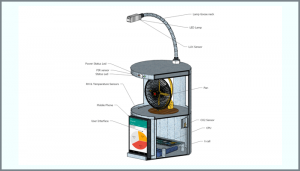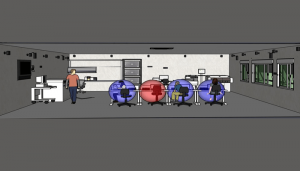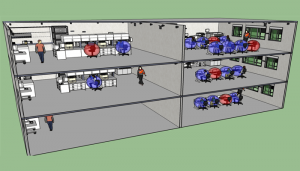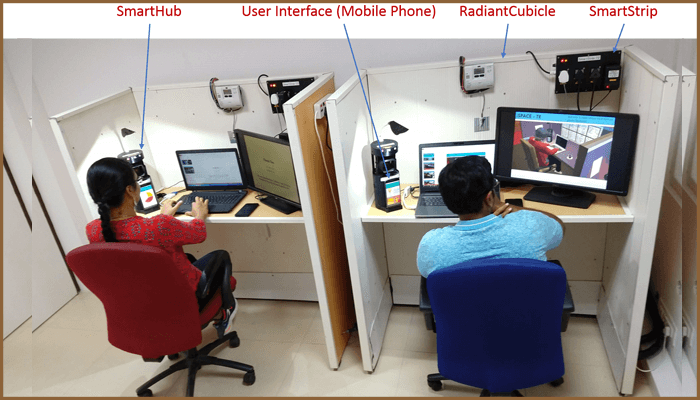Result of R&D Collaboration With Lawrence Berkeley National Laboratory
If you’re the kind who can be found swaddled with 2-3 layers of clothing and shivering away at your workplace while your co-worker is visibly sweating, then this one is for you. In a unique development, IIIT Hyderabad researchers have devised a patented method to integrate personalized controls such as fans, and table lamps for comfort and energy efficiency based on market mechanisms. Read on.
Picture someone whose workstation faces a window versus someone sitting away from any natural light source. The amount of daylight and consequent radiation received impacts the thermal state of the work area. This means that a uniform air conditioning temperature set for this floor will not provide the same level of comfort to the window-facing occupant (who would need a lower setting) and the occupant sitting further away. There are many other factors too that affect individual preferences of comfort such as the kind of clothing, their metabolic activity, and thermal adaptation. These preferences could vary throughout the day as well as on a seasonal basis.
How Personal Environmental Controls Work
Traditionally buildings’ heating, ventilation and air-conditioning systems (HVAC) are adjusted based on occupancy levels and the type of work that is performed. But maintaining such a homogenized indoor environment throughout the building doesn’t address individual comfort needs. This is where personal environmental control (PEC) systems such as the foot warmers, small desktop fans, keyboard warmers, desk lamps, seat headrest personalized ventilation and other similar equipment come into play. Incidentally, we find variations of such systems in aircrafts and railway bogies. These systems have individual controls and are not integrated in a single place. Hence, in the case of buildings, while such provisions improve comfort and satisfaction of the occupants, it does not automatically help in improving energy efficiency.

For instance, to avoid a situation where the entire building is being over cooled while heaters are switched on at individual workstations, it is necessary to have some sort of a feedback mechanism from the personal controls that is integrated with the building controls. In this case, it implies that the cooling set points for the building ought to be increased.
With the entry of renewable sources of energy such as solar panels in the electrical grid, we are witnessing a greater fluctuation in supply of electricity leading to an imbalance in the electrical grid. Typically at the building level, an attempt is made to remove such an imbalance in demand and supply of power via load shedding, albeit crudely. Like, switching off the entire power supply to low priority areas or dimming all lights in the building regardless of the occupants and their needs. In such scenarios, the end-user is unaware of the power imbalance and kept out of the loop to the changes made in consumption patterns.
iSPACE
In a bid to provide more user control to energy consumption patterns, Prof. Vishal Garg and his student Sam Babu Godithi from the International Institute of Information Technology, Hyderabad (IIITH) have invented a unique mechanism funded by the Department of Science and Technology (DST) under the US-India Joint Center for Building Energy Research and Development (CBERD) project. The team’s invention is a system named iSPACE, an acronym for intelligent System for Personal Ambient Control and energy Efficiency. It consists of a SmartHub, and a smart power strip. This system enables networking of all personal environment devices, providing a unified interface to the user, while integrating the personal environment with the building level control systems.


“Here, we are letting users have a say in the manner in which loads can be optimized while exercising a choice on their comfort parameters at the work stations,” says Prof. Garg. PEC systems in themselves are not novel. They existed even in the past, but there was no unified control and interface. This meant that even if the conditions at each floor were known at the building level, there was no way to know the conditions (temperature, humidity, light levels, occupancy, plug loads, and personal preferences) at the individual workstation.
How It Works
The SmartHub consists of an LED lamp, a fan, a mobile phone used as an input device and environmental sensors – temperature, humidity, CO2, illumination and occupancy. It is connected to the PECs, the smart power strip and the building automation and control systems. The SmartStrip consists of an energy meter, a controller, and a tag reader. So whenever any tagged device such as a laptop or a monitor is connected to a socket in the SmartStrip, the SmartStrip can not only report the device being connected, amount of power it is consuming, and the device cost function, but it can also switch on the device or turn it off. At the workstation level, the loads are categorized into three kinds – thermal, lighting and plug loads. In addition to viewing and controlling all devices connected at the desktop, the user can also monitor electricity consumption of each device.

Scenarios
The system is currently being evaluated for two scenarios. One, in which the building publishes the electricity price without any constraint on the load. And the other in which every individual gets a load limit within which she has to operate. In the first scenario, there are price functions which determine the level at which a device needs to operate upon. For example, price function for the coffee machine can be such that the machine can be switched on up to the price of Rs 10/- per unit and turned off when the price exceeds Rs 10/- per unit. Similarly, for an air conditioning device, the price function increases the set point with an increase in the electricity cost. The building publishes the price function and the devices automatically work as per their price functions based on the user preferences, thereby reducing the overall building load when the price of electricity increases.

In the second scenario, the overall permissible building load is distributed to each individual by publishing individual load limits. The individual can optimise the services at the workstation such that the consumption is within the published limit. This can be done manually or automatically by the system. In case, a user has a higher requirement and is unable to contain the load within the prescribed limit, she can use the system to announce her needs and trade the load with other users in the system. In this way, the overall building load can be brought within the permissible limits.
The research team at Lawrence Berkeley National Lab and IIITH are now exploring how this patented technology can be commercialized.
The patent document can be viewed here. [https://patents.google.com/patent/US10496066B2/en]

Sarita Chebbi is a compulsive early riser. Devourer of all news. Kettlebell enthusiast. Nit-picker of the written word especially when it’s not her own.


Next post